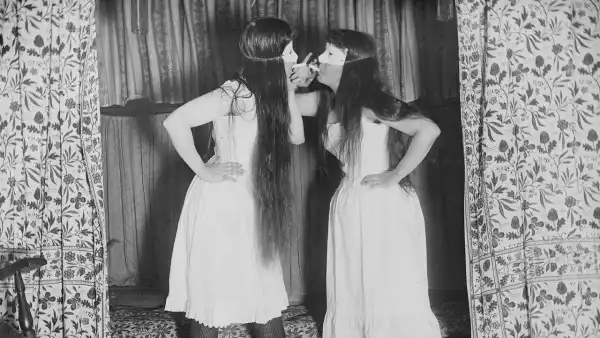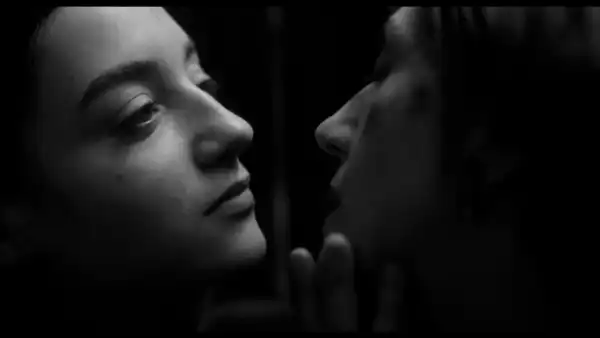
Save this storySave this storySave this storySave this story
The Alice Austen House is a Gothic Victorian abode situated on Staten Island’s coast, and on the pleasant autumnal day I went, the vista of the harbor was vibrant and cerulean. Within, the atmosphere carried a scent reminiscent of the ocean, an apt complement to the ongoing exhibit: “She Sells Seashells,” organized by Gemma Rolls-Bentley, a study of creations by queer female artists who’ve discovered liberty and kinship by the sea.
Alice Austen was a photographer from the early twentieth century who resided for much of her life along this particular stretch of coast, at first with her family and subsequently with her companion, Gertrude Tate. A shoreline photo of hers, lacking a date, presents three women set along the water’s edge, a sense of elation evident in their stances despite their faces being turned away. Her body of work, featured across the exhibit, implies a hushed yet firm origin for the more outspoken works displayed by present-day artists. Within Austen’s 1885 photo titled “Group in Bathing Costumes,” a quintet of women strike a pose in lively bloomers and tunics falling to the knee, exposing notably less skin, though with just as much spirited confidence, as the unclothed cartoonish female warriors frolicking within Ana Benaroya’s 2022 drawing “By the Ocean’s Roar.” Rolls-Bentley, in the show’s preface, expresses that the recent pieces “are in conversation” with Austen’s, “intertwining intimate accounts and shared memories into a shoreline-anchored collection of yearning, solicitude, likelihood, and revitalization.”
 A depiction of a “Group in Bathing Costumes,” September 17, 1885.
A depiction of a “Group in Bathing Costumes,” September 17, 1885.
The Alice Austen House began as a seventeenth-century Dutch construction, which Austen’s mother’s affluent family progressively transformed into an escape from Manhattan. They dubbed it Clear Comfort. Alice was raised there amidst both privilege and unorthodox circumstances: shortly after her birth, her father deserted his spouse and offspring, prompting them to take up residence with her mother’s kin. Clear Comfort was the place where Alice, as the cherished only child within a household of adults, gained proficiency in photography. An uncle introduced a camera into the home and showed her its operation; upstairs, inside a shadowed room akin to a linen closet, she processed her images.
 Austen herself referred to this image as “A Walk to Point Sagamore, Lake George, NY, August 31, 1913.”
Austen herself referred to this image as “A Walk to Point Sagamore, Lake George, NY, August 31, 1913.”
Photography was not a rare interest for a young woman of her standing, and many of Austen’s initial images portray a realm of cultured Victorian diversions—gatherings held on verandas and scenic outlooks, joyful pugs, radiant days in puffed sleeves. (She also created a wealth of documentary photos, depicting “Street Types of New York” along with the quarantine facility on Ellis Island, a collection of works that distinguishes her as among the earliest female photographers to operate beyond the confines of a studio.) Still, the pictures which have garnered Austen a small but fervent following are strikingly intimate and astonishing. To cite instances: Austen together with two of her female acquaintances outfitted in male attire and counterfeit mustaches, acting silly while in a state of laughter; Austen, once more accompanied by two female companions, all situated in a bed, arms arranged behind their craniums; and—perhaps most indelibly—Austen and another woman, their flowing hair let down, sporting white undergarments together with diminutive white masks, holding cigarettes while their countenances are brought near.
 Alice Austen, Julia Martin, and Julia Bredt, October 15, 1891.
Alice Austen, Julia Martin, and Julia Bredt, October 15, 1891.
Such images are displayed at the Alice Austen House across a partition labeled “The Larky Life,” which was the photographer’s phrase for leisure pursuits on the whole. The social sphere perceived through her lens—women riding cycles, women engaged in tennis, women embracing one another—possesses an undeniable vibrancy. It’s straightforward to conceive of that realm being appropriated for one of those TV programs wherein the young individuals in corsets partake in daring escapades set against anachronistic pop songs, akin to “Dickinson” or “The Buccaneers.” Indeed, there exist at least a pair of Y.A. literary works focusing on Austen: one, “Renegade Girls,” crafted by Nora Neus, which stands as a graphic novella concerning queer romance taking place within the photographer’s era; another, “Alice Austen Lived Here,” penned by Alex Gino, telling the tale of modern-day queer adolescents unearthing her creations. (The curator Bonnie Yochelson’s Austen biography, launched earlier in the year, adopts the humorous designation “Too Good to Get Married.”) The museum wholeheartedly embraces the sense of individual rapport its subject instills. “To be effective at this position, one must hold affection for Alice,” the executive director, Victoria Munro, revealed to me. Austen herself lingers as somewhat of an enigma: her personal correspondence has been misplaced, rendering instances of her distinct voice scarce. Nevertheless, remaining letters sourced from her circle of friends hint at the traits of someone versed in experiencing enjoyment. A companion, eager for Austen to unite with her on an upstate getaway, puts in writing a portrayal of the sorts of antics awaiting: “I’ve never enjoyed laughter so heartily in my entire existence. I was the sole girl present, and the singing and clamor were unparalleled . . . You should be sure to have your banjo in tow.” (In 2022, those letters functioned as the framework for a podcast denoted as “My Dear Alice,” brought into being by the artist Pamela Bannos working alongside the Alice Austen House.)
 Austen had written, “Mrs Snivley, Jule, and I in Bed, Bennington, VT, August 29, 1890.”
Austen had written, “Mrs Snivley, Jule, and I in Bed, Bennington, VT, August 29, 1890.”
“She’s likely been a leader,” Munro affirmed, as we pondered the “Larky Life” exhibition. “It’s certain that she had to coax her acquaintances into holding all of these poses.” That was a valid point: beyond prevailing societal restrictions, Austen was compelled to consider the technological confines of the period. She worked employing a hefty box-shaped camera crafted from wood, potentially weighing as much as fifty pounds at capacity, and Munro gauged that a domestic photo, such as that of the masked portrait, would’ve necessitated its subjects to remain still across an exposure lasting from thirty seconds to a full minute. To capture a risqué image called for considerable dedication.
 Tate and Austen pictured in France, September 13, 1905.
Tate and Austen pictured in France, September 13, 1905.
Austen’s course, akin to those of many artists within New York, ultimately turned upon the twists of property. At Clear Comfort, she fashioned a life characterized by notable autonomy—for a period of three decades, she dwelled alongside Tate, with whom she had experienced love during a Catskills holiday. (One lively series of images captures a youthful Tate frolicking outdoors in sunlight.) Alas, Austen’s inheritance diminished within the crash of 1929, compelling her and Tate, following attempts to sustain themselves, to part ways with a vast array of their goods—housing even a collection of shells, imbuing a melancholic nuance to the exhibition’s current designation. By 1944, they traded the abode. Tate eventually relocated to be with her family, who rebuffed Austen; Austen found residency at the Staten Island Farm Colony, an establishment for the impoverished.
 Alice Austen (situated at the left) in consort with Gertrude Tate, inside Pickards Penny Photo Studio, to be found within Stapleton, Staten Island.
Alice Austen (situated at the left) in consort with Gertrude Tate, inside Pickards Penny Photo Studio, to be found within Stapleton, Staten Island.
A previous writer for Life magazine happened upon Austen’s works during 1951, and a renewed swell of curiosity along with reinforcement brought back to her a degree of ease, ahead of her passing in 1952. Clear Comfort stood preserved because of the endeavors of Austen’s recent devotees (incorporating even the photographer Berenice Abbott). It functioned for a stint as a rather standardized museum of historical housing: the partitions held back via ropes showed a collection of furniture approximately from that era, though there was scant material that tied it specifically to Austen’s life there. The official accounts of the dwelling glossed over her bond to Tate, spurring the activist organization known as the Lesbian Avengers toward staging a demonstration just outside of it within the nineties. Notwithstanding that, by 2017, it earned the recognition of a National L.G.B.T.Q. Historic Site, and these days it thrusts Tate to the forefront as a vital element of the narrative that involves Austen.
Sourse: newyorker.com






